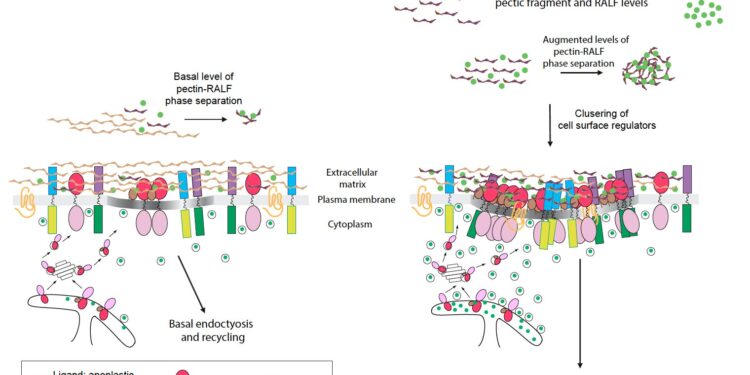The researchers focused on the sugar pectin, the receptor proteins FERONIA and LLG1, and the signal peptide RALF to understand how plants respond to stimuli. Credit: Cell (2023). DOI: 10.1016/j.cell.2023.11.038
A team of researchers from the University of Massachusetts Amherst recently published a pioneering study that answers a central question in biology: how do organisms mobilize a wide range of cellular processes when they encounter change, whether in internal or in the external environment, to thrive in good times or survive bad times?
The research, focused on plants and published in Cell, identifies the interactions between four compounds: pectin, the receptor proteins FERONIA and LLG1 and the signal peptide RALF. In particular, the team discovered that a molecular condensation process, called liquid-liquid phase separation, which occurs between pectin and RALF at the cell wall-cell membrane interface, governs how a stimulus triggers many cellular processes. Together, these processes generate a response beneficial to the plant.
“Biologists often work in a linear fashion: we observe the arrival of a stimulus, then we monitor a specific response along a certain cellular pathway that we believe is causing that response. But in reality , cells maintain a multitude of pathways, which are carefully maintained and must be coordinated at all times,” says Alice Cheung, professor emeritus of biochemistry and molecular biology at UMass Amherst and senior author of the paper.
Cheung and his long-time collaborator and co-lead author Hen-Ming Wu have been thinking about the question of stimulus and response since they discovered in 2010 and 2015 that the FERIONIA-LLG1 receptor pair is an ideal candidate for solve this difficult puzzle. . FERONIA-LLG1 impacts almost every aspect of plant life: the growth of a just-germinated seedling to maturity and reproduction of the next generation, and resistance to all kinds of challenges in between, such as disease and climate extremes.
“It took many years on the part of two very dedicated young colleagues, postdoctoral researcher James Ming-Che Liu and graduate student Jessica Fang-Ling Yeh, the co-first authors of the paper, and a doctoral student in biology molecular and cellular graduate, Robert Yvon,” says Cheung. “Together they carried out a series of studies that started from different angles but were deliberately designed to provide a coherent story, impossible to tell any other way.”
The investigation began with an investigation into how the RALF signal (or ligand) affects FERONIA-LLG1 in the cell membrane. The team observed surprising results: The cell did not simply take FERONIA-LLG1 into the cell, a process known as endocytosis and a typical response; every cell membrane molecule tested by the team was affected. Furthermore, unlike the typical ligand-receptor interaction, the RALF ligand remained outside the cell in a pectin-rich extracellular matrix called the cell wall.
The team then examined the biochemical and biophysical interactions between the four molecules, how these interactions affect the behavior of these molecules at the cellular level, and how they affect plant physiological outcomes using two often encountered environmental stresses: temperature and salinity. high.
The results provide, for the first time, a mechanism to explain how plant cells coordinate many different pathways in response to a single stress signal to become more resilient and survive. The work also demonstrates for the first time how phase separation at the cell wall-cell membrane interface, the front line where a plant cell detects and responds to external stimuli, can profoundly affect a collective cellular response.
Cheung adds that “the work could not have been carried out without the core facilities of the Institute of Applied Life Sciences and the contribution of James Chambers, director of the Light Microscopy Core and co-author of the paper.”
More information:
Ming-Che James Liu et al, Pectin-RALF extracellular phase separation mediates global signaling function of FERONIA, Cell (2023). DOI: 10.1016/j.cell.2023.11.038
Provided by University of Massachusetts Amherst
Quote: Researchers uncover key to molecular mystery of how plants respond to changing conditions (February 6, 2024) retrieved February 6, 2024 from
This document is subject to copyright. Apart from fair use for private study or research purposes, no part may be reproduced without written permission. The content is provided for information only.



